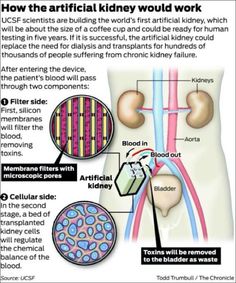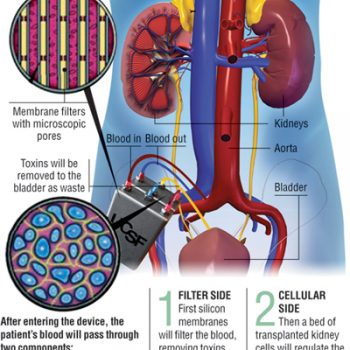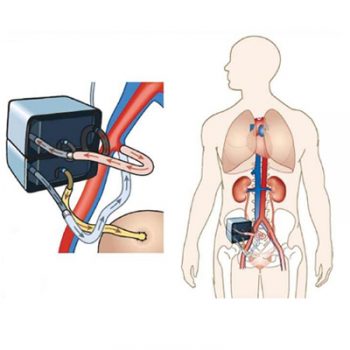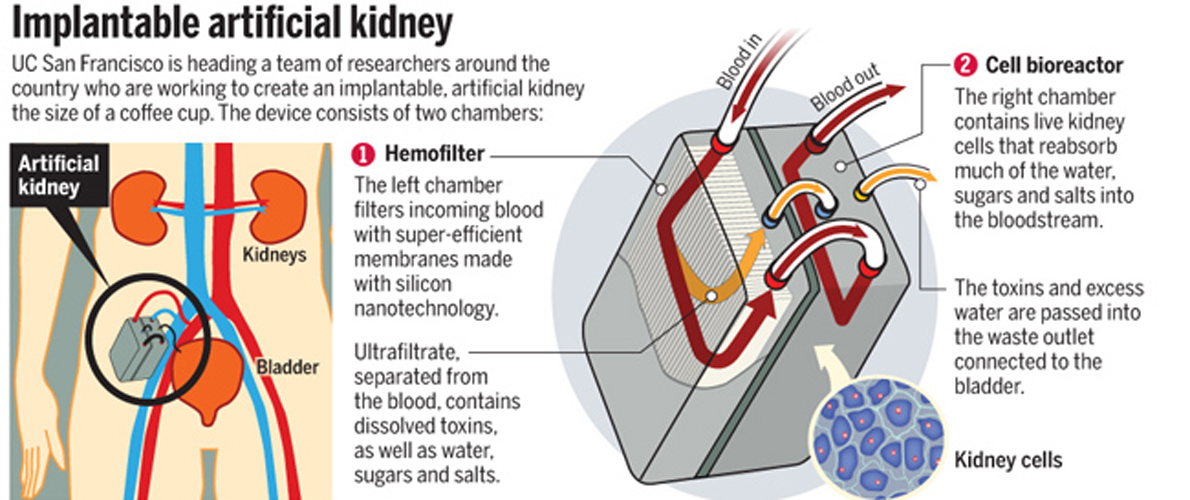The Dream of an Artificial Kidney (microchips) is a Step Closer to Reality
An implantable artificial kidney could transform prospects for people whose kidneys have failed and who have to rely on dialysis or the rare chance of a transplant to stay alive. Now, researchers working on the first-of-its-kind device that aims to meet this need says they are hopeful of running pilot trials in humans within the year.
The researchers plan to start pilot trials of the microchip filter in dialysis patients by the end of 2017.
The implantable artificial kidney contains microchip filters and living kidney cells and will be powered by the patient’s own heart.The microchip uses the same silicon nanotechnology that the microelectronics industry uses for computers.Each device will contain about 15 microchips, one on top of the other.
Each microchip filter contains pores, each of which will contain and act as a scaffold for a membrane of living kidney cells that mimic the natural functions of the kidney. The team is designing the filter one pore at a time to do precisely what they want each to do.
The microchips are also the scaffold in which living kidney cells will rest, using live kidney cells that will grow on and around the microchip filters. The goal is for these cells to mimic the natural actions of the kidney.
In the artificial kidney, blood brought into one side of the device passes through a silicon filter that removes toxins, sugars, salts and water, creating an “ultrafiltrate.”
The filtrate would move to the other side of the device, where actual kidney cells would reabsorb the water, sugars and salts back into the bloodstream, mimicking a real kidney’s metabolic and water-balancing roles in a way that dialysis cannot. The team obtains the kidney cells from organs rejected for transplantation.
Artificial kidney could last for decades. The device does not require a source of power because it uses the power of the patient’s heart – the natural pressure of blood flow in the blood vessels – to push the blood through the filters.
Because the bio-hybrid device will be out of reach of the body’s immune response, it is unlikely to incur rejection. The team is hoping to run pilot trials of the silicon filters by the end of 2017.
As the prevalence of diabetes increases, and as many diabetics live longer, we can expect an increase in the numbers of those being treated for ESRD.
This will be a boon for all patients with chronic kidney disease (CKD). At present in India, of the 1.5 lakh new patients who suffer from endstage renal failure annually, only 3,500 get kidney transplants and 6,000-10,000 undergo dialysis. The rest perish due to an acute shortage of dialysis centres and nephrologists to man them. CKD is rising at a rapid pace in India and the majority of those who perish are either unable to find a suitable organ for transplantation or are unable to pay for the high dialysis costs. The artificial kidney, when available and if affordable, will be a miracle.’’
‘‘Artificial kidney will be boon for India,’’
Dr Dinesh Dhanda, Director KidneCare RAMA Superspecality hospital, Karnal(Haryana).
“We are creating a bio-hybrid device that can mimic a kidney to remove enough waste products, salt and water to keep a patient off dialysis.
“William H. Fissell
“The issue is not one of immune compliance, of matching, like it is with an organ transplant,” Prof. Fissell
“My patients are absolutely my heroes. They come back again and again and they accept a crushing burden of illness because they want to live. And they’re willing to put all of that at risk for the sake of another patient.” Prof. Fissell
“We realized we could achieve a dialysis filter that would be one-twentieth the size of what’s commercially available, and would require so little power that we could drive it just off blood pressure alone,” said Shuvo Roy





